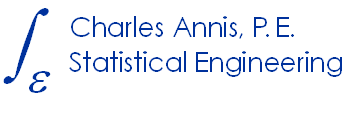2 + 2 = 5
Two Questions:
1) Is this statement VALID?
2) Is this statement TRUE?
The Answers:
- The statement “2 + 2 = 5” IS valid. Addition is defined as a binary operation, having two operands, the operation symbol, and the equals sign. All are present. The statement is valid.
- The statement is obviously false. All valid arithmetic statements are not true, and this leads to untold grief.
The most common mistake engineers make in “doing statistics” or “doing probabilistics,” is to write down a valid statistical statement that is false(*), then vociferously argue over the statement’s validity, and the subsequent stream of valid arithmetic operations that lead to the (erroneous) conclusion, which they fervently believe must be correct since the original statement was “correct.”
But valid arithmetic statements are not all true statements. We aren’t interested in the statement’s VALIDITY; we are interested in the statement’s VERACITY. And the distinction between the two is often ignored.
Lesson:
Just because you can make a statistical statement doesn’t make it true, no matter how much you wish that it were.
* Note:
We engineers aren’t stupid, just statistically inattentive. We wouldn’t write down something that is obviously false, like “2 + 2 = 5” but we often do write down something false that would be true if certain conditions in the statistical fine-print were met, which they aren’t, so the statement is false at the outset.

